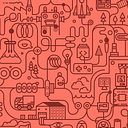The Common Thread: Work Doesn’t Happen Alone
I’m very fortunate to work for a company that regularly invests in its employees. One of the ways that we do this in my department is by getting together quarterly over lunch for the normal celebratory announcements coupled with a bit of learning. Today, we had three guest speakers — two from within the company and one external — with differing messages on the surface yet a common thread throughout appeared.
Relationships & Listening
First off, the vice president of one of our major workgroups related how he went from a bookie on the Vegas strip to the leader of 18,000 employees. In telling his story, he touched on a couple of leadership qualities that resonate the most with him and that have contributed greatly to the success of the leaders at our most high performing location: building relationships and listening. We are a relationship driven company. We pride ourselves in making connections with our customers and providing them with the highest level of service possible while we happen to fly them from point A to B.
Relationship building — and customer service for that matter — doesn’t start with customers though…it starts with employees. We can’t serve customers to the best of our ability if we try to do it alone. It doesn’t work that way. So, to achieve the highest level of customer service, it takes a team effort. To have a high functioning team, we have to have trust and respect. We have to have established strong relationships. To establish strong relationships, we have to listen to one another.
We can’t have effective communication without proper receipt of the message.
Listening is a skill that far too often is undervalued, underused, and undertrained. We like to talk at each other. We like to nod and smile, all the while formulating what we are going to say next and not really hearing a word. We like to take notes instead of really letting the words being said soak in. Leaders need to listen to their employees. We all need to listen to our coworkers. And, employees need to listen to their customers. We can’t have effective communication without proper receipt of the message.
Continuous Improvement, Advanced Analytics, & Innovation
Our next speaker was the leader of strategy and innovation for our company. His position is relatively new, and quiet frankly, he is forging much of what he is doing as he is doing it. Strategy and innovation are about change. He took pride in calling himself, not only someone that embraces change, but as an instigator of change. You cannot achieve strategic goals and aspirations or evolve the way things are done without change.
A big piece of change that was discussed was a shift from silos to systems. In an operation where everything operates in silos, each silo can master its craft honing what it needs to accomplish to peak efficiency. This isn’t a bad thing, although most of the time when you hear the word “silo” in a business context the connotation is in fact a negative one. Systems of silos get work done. However, silos work best at smaller scales. As business operations grow larger and larger, siloed systems can wreak havoc on achieving intended goals. They can also result in duplication of effort, misaligned priorities, and many other detrimental and undesired outcomes. Systems thinking, however, cuts across the boundaries put up by silos and views processes as they truly operate. At large scale, systems thinking is required to ensure that appropriate activities are working together to achieve the intended results. Systems thinking looks across the silos to understand the whole. As companies, business units, and operations grow — or want to achieve exponential growth — a shift in thinking from silos to systems is likely in order.
Innovation is harnessing “what is” with “what is possible.”
To move then from thinking and operating in silos to thinking and operating as systems a few things are required: continuous improvement, advanced analytics, and innovation. As an entity, a mindset of continuous improvement needs to be instilled. CI isn’t new; there are many models out there. But CI is truly more than a model or a one-off activity that happens every few years. CI has to be continuous. And to be continuous, it must be engrained in the way everything is approached. How can this thing I am about to do be made better? How can I complete my task more efficiently? How can the quality of my work be increased? If you are going to embrace the mindset of CI, you are going to need data — lots of data. Some might (and often) even call it big data. Measurement is increasingly a major part of everything we do, and data points are multiplying at exponential rates as anything with a plug or battery is in the process of getting a sensor hooked into it so it can capture and beam that data somewhere. Continuous improvement, matched with data and analytics to drive decision science, leads then to innovation. Innovation is harnessing “what is” with “what is possible.” Innovation brings new methods and outcomes to bear on the current state whether problematic or not.
Sharing & Collaboration
The last speaker in our lineup today was a collaboration strategist from IBM. We brought in Mac Guidera to talk to our department as we have recently launched IBM Connections to the group. They are some of the first employees with access to Connections as a collaboration platform that will be integrated with our intranet this fall.
Today’s collaboration tools empower the workforce with more flexibility, reach, and influence than ever before.
Mac spoke to the group about the value of sharing — how we in fact learned to do this all the way back in kindergarten — and how collaboration is a big part of how work is done 2016. At IBM, they often like to refer to the shift in work that we are currently seeing as A New Way to Work. And, I agree. Today’s collaboration tools empower the workforce with more flexibility, reach, and influence than ever before. This shift in how we work is enabling shifts in culture and engagement as well.
Teams that collaborate are happier. They have stronger relationships. They listen to one another. They are not afraid to change the status quo…to improve upon what they do or how they do it. They work together to make informed decisions and are innovating new ways for their companies to be successful.
Work Doesn’t Happen Alone
These three speakers today were not chosen to convey a common theme. They were not coached into weaving together stories that fit nicely as a broader whole. But as I sat and listened, a common theme did surface for me: we don’t work alone. We work with others — whether on the front end, throughout the entire process, or as a part of delivering the outcomes of our labor.
My perspective is that of someone working to transform the way his company works — to introduce tools to the workforce that enable them to reach and connect with coworkers from any location, to share what they do across boundaries, to build upon one another’s ideas, to collaborate in getting the job done. I freely admit that my perspective is biased. However, it is undeniable that we need our fellow coworkers to accomplish our company’s lofty mission and vision statements.
Digital transformation and enterprise-wide, collaborative platforms give employees an environment to achieve results. And when our employees are given the right tools for the job, there are no limits to what they can achieve.

